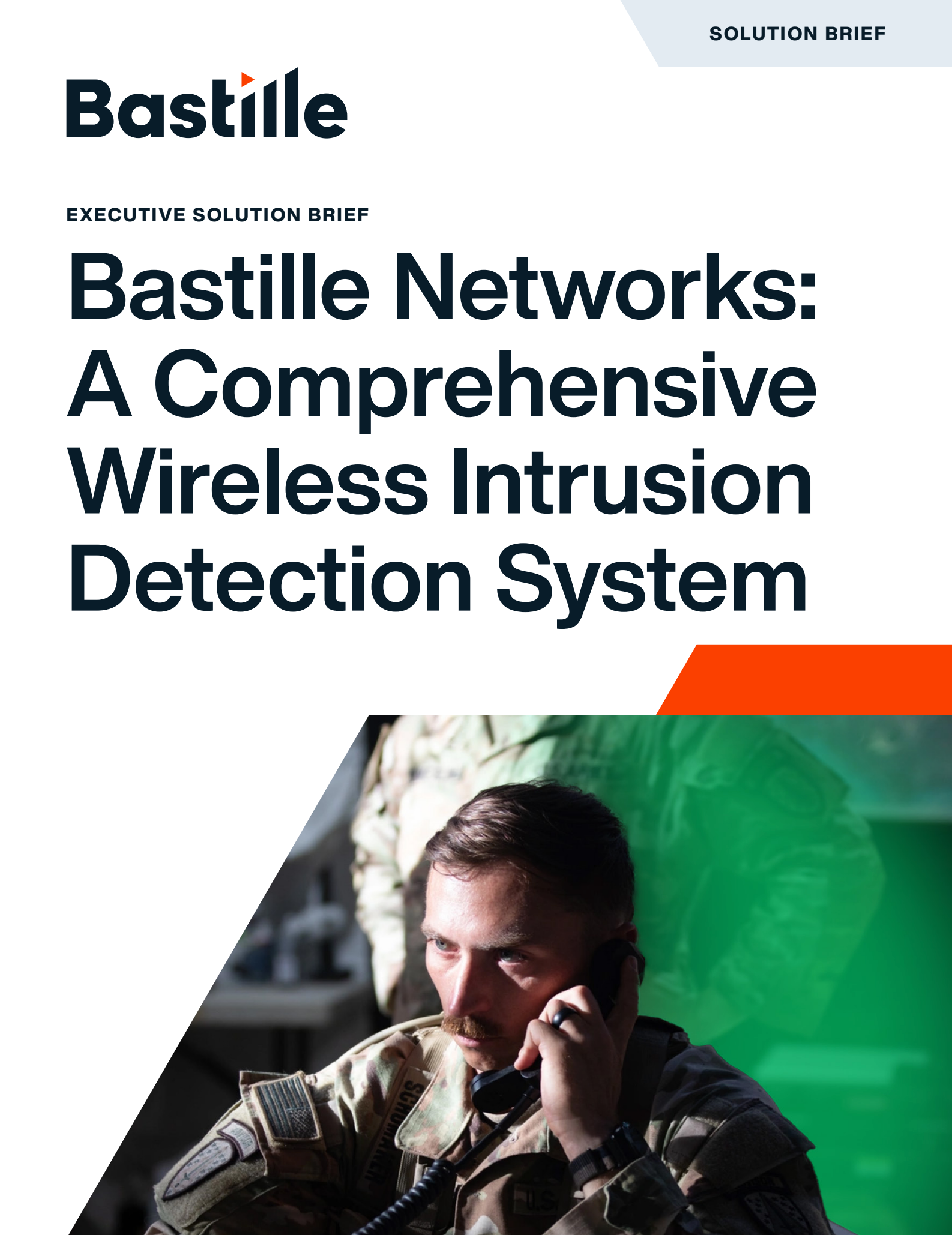
Wireless technologies are everywhere. Our phones, IoT devices, and even building systems rely on them. But in Sensitive Compartmented Information (SCI) environments, wireless presents unique risks to the confidentiality of classified information. Regulations clearly and broadly prohibit wireless use unless the device receives a specific waiver.
Bastille works with government and defense organizations to help them understand these risks, implement required controls, and maintain visibility into the airspace.
Why SCI Environments Prohibit Wireless Devices
SCI facilities (SCIFs) exist to protect some of the nation’s most sensitive information. Any device capable of transmitting data beyond secure boundaries introduces risk. The Cognizant Security Authority (CSA) considers the following among the primary wireless risks:
- Signal Leakage and Eavesdropping – Wireless transmissions can extend beyond the secure perimeter, allowing adversaries to collect sensitive information without entering the facility.
- Covert Channels – A compromised smartphone, smartwatch, or IoT sensor could act as a hidden transmitter to exfiltrate classified data.
- Unauthorized or Rogue Devices – Personal hotspots, BYOD devices, or rogue access points create uncontrolled pathways.
- Compromise of Approved Systems – Even authorized radios and secure cellular systems are vulnerable to exploitation through weak encryption, misconfiguration, or malware.
- Spectrum Complexity – The proliferation of LTE, 5G, and IoT protocols makes it increasingly challenging to identify anomalous activity without dedicated monitoring and analysis.
These risks highlight why SCI environments default to a “no wireless” policy unless a waiver explicitly authorizes use.
When Exceptions Are Permitted
Despite the risks, certain situations require limited wireless use in SCI facilities, such as the use of approved medical devices or emergency radios. The CSA has a formal waiver process for exceptions and reviews any requests for approval. A waiver typically requires:
- Mission Justification – Why wireless is essential and no wired option exists.
- Technical Safeguards – Security measures that will be in place, such as encryption and RF monitoring.
- Operational Controls – Procedures for introducing, registering, and monitoring devices.
Key documents that define these rules include:
- ICD 503 – Intelligence Community Information Technology Systems Risk Management Framework, which governs IT system security.
- CNSSI 1253 – Security Categorization and Control Selection for National Security Systems, which tailors NIST SP 800-53 controls for SCI systems, including the requirement for Wireless Intrusion Detection Systems (WIDS).
- NIST SP 800-53 – Security and Privacy Controls for Federal Information Systems and Organizations, which establishes the baseline wireless and radio frequency monitoring requirements.
- DoD 5200.01 – DoD Information Security Program, which reinforces the prohibition on unauthorized wireless.
- ICD 705 – Sensitive Compartmented Information Facilities (SCIFs) Physical and Technical Standards, which define construction, shielding, and TEMPEST/RF attenuation requirements to prevent signal leakage.
- ICD 124 – National Policy on Technical Surveillance Countermeasures (TSCM), which requires detection and mitigation of technical surveillance threats, including RF-based devices.
Together, these directives define both the information security and counterintelligence requirements for controlling wireless threats in SCI environments.
Common exceptions include:
- Mission-Critical Communications – Secure tactical radios or cellular systems may be authorized when wired alternatives are not feasible.
- Medical and Safety Devices – Wireless-enabled medical implants (e.g., pacemakers, insulin pumps) and emergency responder radios are exempt from this requirement.
- Operational Necessity Systems – Building systems such as wireless fire alarms, emergency notification systems, or environmental controls may be permitted.
- Controlled Testing and Research – The CSA may allow the introduction of RF-enabled devices for evaluation or test purposes under a waiver.
Security Requirements for Exceptions
When wireless devices are approved, they come with strict compensating controls:
- Continuous RF Monitoring – Facilities must deploy persistent spectrum monitoring and Wireless Intrusion Detection Systems (WIDS), which satisfy both CNSSI 1253 control requirements and ICD 124 TSCM mandates, and align with NIST SP 800-53 controls (e.g., SI-4, SC-7, AC-18, and CA-7).
- Facility Standards – SCIFs must comply with ICD 705 shielding and construction requirements to minimize the risk of wireless leakage.
- Medical Device Management – FSOs and security staff must account for exempted medical devices through registration, escort policies, and compensating monitoring, since they cannot modify them to meet standard RF security requirements.
- Physical & Procedural Controls – Device registration, logging, escorts, and inspections to prevent untracked introduction of RF devices.
- Encryption & Frequency Restrictions – Devices must use government-approved encryption and operate only within designated spectrum.
- Separation from SCI Networks – Approved devices must remain air-gapped from SCI IT systems.
How Bastille Strengthens SCI Wireless Security
Bastille delivers the visibility, control, and forensic depth required to secure SCI facilities against wireless threats while supporting compliance with government directives:
- 100% Passive Monitoring – Bastille operates silently, listening to the airspace without transmitting any signals. Organizations can maintain continuous coverage without introducing new RF emissions into their secure environment.
- Broad Spectrum Coverage – Bastille monitors from 100 MHz to 7.125 GHz, covering Wi-Fi, Bluetooth, Zigbee, LTE, 5G, and other protocols. This function provides detection of both legacy and emerging wireless technologies.
- Real-Time Threat Detection – Bastille identifies unauthorized devices and suspicious activity the moment they appear, enabling operators to take action before an incident escalates.
- Device Localization – Unlike traditional WIDS solutions that only provide alerts, Bastille pinpoints the physical location of devices inside or near the SCIF. This capability reduces investigation time and enables rapid mitigation of incidents.
- Audit and Forensics – Bastille maintains a complete record of wireless activity, enabling organizations to demonstrate compliance with CNSSI 1253 and NIST SP 800-53, support ICD 124-mandated TSCM sweeps, provide evidence during investigations, and verify facility protections under ICD 705.
- Compliance Alignment – Bastille’s capabilities directly support the requirements outlined in ICD 503, CNSSI 1253, NIST SP 800-53, DoD 5200.01, ICD 705, and ICD 124, making it an essential tool for organizations seeking both operational security and regulatory adherence.
Compliance Mapping: Wireless in SCI Environments
| Directive | Wireless Requirement | Bastille Capability |
| ICD 503 – Intelligence Community IT Systems RMF | Apply risk management to IT systems, prohibit unauthorized wireless, and document exceptions through the waiver process. | Bastille provides continuous visibility into the RF spectrum, supporting risk management decisions and incident documentation for waiver compliance. |
| CNSSI 1253 – Security Categorization & Control Selection | Tailors NIST SP 800-53 for SCI systems; mandates Wireless Intrusion Detection Systems (WIDS) for classified environments. | Bastille delivers a 100% passive WIDS with broad spectrum coverage (100 MHz–7.125 GHz), detecting unauthorized devices and monitoring exempted medical devices with compensating visibility. |
| NIST SP 800-53 Rev. 5 – Security & Privacy Controls | Control families include: AC-18 (Wireless Access Restrictions), SC-7 (Boundary Protection), SI-4 (System Monitoring), and CA-7 (Continuous Monitoring). | Bastille enforces wireless access restrictions, provides compensating RF monitoring for exempt medical devices, and supports continuous monitoring with real-time detection and forensic audit logs. |
| DoD 5200.01 – DoD Information Security Program | Prohibits unauthorized wireless technologies in classified environments; requires strict controls for approved exceptions. | Bastille identifies and locates rogue or unauthorized devices, supporting enforcement of DoD restrictions. |
| ICD 705 – SCIF Physical & Technical Standards | Defines shielding, TEMPEST, and construction standards to reduce RF leakage risk. | Bastille validates ICD 705 protections by continuously monitoring for RF leakage and unauthorized emissions around SCIF boundaries. | |
| ICD 124 – National Policy on Technical Surveillance Countermeasures (TSCM) | Requires programs to detect and neutralize technical surveillance threats, including RF-based exfiltration. | Bastille provides persistent RF monitoring, supports TSCM sweeps, and captures forensic data for counterintelligence investigations. |
In short, Bastille extends the security boundary of SCI facilities into the wireless domain, enabling security teams to detect, locate, and investigate wireless threats with confidence.
Conclusion
Wireless use in SCI facilities is the exception, not the rule. Regulations from ICD 503, CNSSI 1253, NIST SP 800-53, DoD 5200.01, ICD 705, and ICD 124 provide strict guidelines for both IT security and counterintelligence activities. Any authorized use must pair with layered security measures.
Bastille helps government and defense organizations meet these requirements by providing continuous visibility into the wireless spectrum, detecting threats, and supporting both compliance and TSCM mandates.
By combining regulatory adherence with advanced wireless monitoring, organizations can reduce risk and protect mission-critical information.



